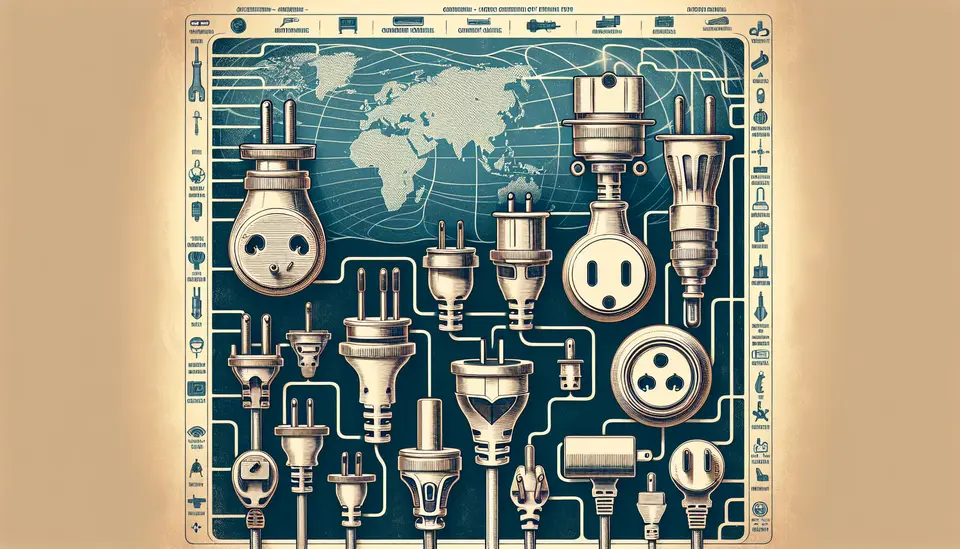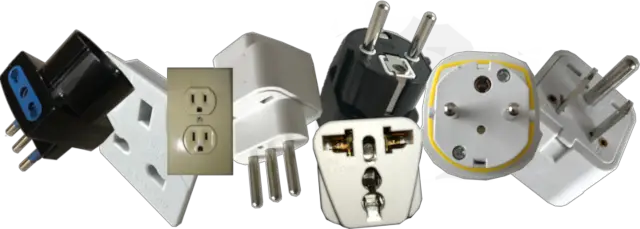The Evolution of Power: Tracing the Global History of Plug Designs
Taylor Watts - January 03, 2024
 Old Plugs
Old Plugs
Ever wondered why a travel adapter is a globetrotter's best friend? Dive into the captivating history and evolution of global plug designs with our expert Taylor Watts and power up your travel knowledge! 🌐🔌✨
The Evolution of Power: A Journey Through the History of Plug Designs Around the Globe 🌐✨
Hello, fellow wanderlusters and tech-savvy nomads! It's your go-to gadget girl, Taylor Watts, here to guide you through the fascinating maze of power plugs and socket designs that literally keep our digital lives charged up while globetrotting. So, grab your favorite cup of coffee, and let's dive into the electrifying world of plug designs! 🌟
A Spark from the Past: The Birth of the Plug 🔌⚡️
Picture this: it's the late 19th century, and electric power is becoming the new shiny toy for the more affluent households. The earliest systems were a bit like the Wild West — unstandardized, with each manufacturer doing their own thing. It was Thomas Edison who introduced the first plug and socket system, basically bringing order to chaos. His design, albeit primitive, lit the spark that powered the march towards modern plug designs.
Branching Out: The Divergence of Standards 🌳✈️
Why do we have different plug types, you ask? Well, as electricity became more widespread, countries developed their systems independently. This led to the fascinating diversity we have today. It seems everyone wanted a piece of the pie, but nobody could agree on the flavor!
The American Standard: Type A and B 🔵🔴
- In North America and parts of Central and South America, we see the Type A and B sockets. The former is your classic two-flat-prong design while the latter adds a grounding prong for safety.
The British Brainchild: Type G 🔍🇬🇧
- The United Kingdom decided to go one step further with the chunky, rectangular Type G socket, featuring three rectangular prongs and a built-in fuse for each plug — talk about being extra cautious!
The Continental Connection: Types C, E, and F ⭐️🌍
- Over in Europe, they've got a smorgasbord of plug types. The Type C is the ungrounded traveler, the ever-so-common two round pins found in many a European backpacker's bag. Then, there's Types E and F which are grounded and look quite similar, but with a bit more personality in their design.
The Outliers: Types D, H, I, K, L, M, N, O... 🌀🔍
- It's like the alphabet soup of plugs in other parts of the world. From India's Type D, Israel's unique Type H, the slanted Type I in Australia, down to Brazil's recent innovation of the Type N — each region has tailored their sockets to their standards.
The Tech Behind the Design: Functionality Meets Safety 🛡️💡
Now, listen up, my tech aficionados — the design of these plugs isn't just about aesthetics. It's a marriage of functionality and safety. For instance, the third grounding pin in many designs isn't there to make the plug look snazzy. It's a safety feature to protect you from electric shocks. And those shutters on British sockets? They keep curious little fingers safe from electrical harm.
The voltage and frequency also differ around the world. While your hairdryer may love the 120 volts in the U.S., it could have a meltdown with the 230 volts in Europe unless it's dual-voltage. And let's not forget the shape and size of the pins. They're not just designed to frustrate jet-setters; they make sure the plug fits snug as a bug in the outlet, ensuring a secure electrical connection.
A Harmonious Future? The Push for Standardization 🌿🤝
With the growth of international travel and the boom in electronic devices, there's a cry for standardization. Wouldn't it be lovely to use one adapter for all your adventures? Organizations like the International Electrotechnical Commission (IEC) have been trying to simplify things with their own universal standard: Enter the Type N socket, introduced in Brazil. However, old habits die hard, and changing infrastructure is like convincing a cat to take a bath — challenging, to say the least.
The Modern Traveller's Companion: Universal Adapters and Converters 🌟🎒
As we eagerly await a one-plug world, let's chat about the jet-setter's temporary fix: the universal adapter. These nifty devices are like the Swiss Army knives of the electrical world. They can morph to fit various socket types but remember, they're adapters, not converters. If you've got a gadget that's picky with voltage, you'll need a converter to keep it from frying.
Travel Tips for the Electronic Explorer 🚀🌍
Okay, so now that we're practically electrical connoisseurs, let's look at some travel tips to ensure we're powered up and ready to go:
- Check Your Gadgets: Before you pack that e-reader or camera, check if it's dual-voltage (usually marked 100-240V).
- Invest in Quality: A good universal adapter is a worthy investment. Look for one with surge protection to shield your precious devices.
- Research Before You Go: It's worth a quick check to see what type of sockets your destination uses. You don't want any sparks flying, except maybe from the excitement.
- Be Adapter Savvy: Not all adapters are born equal. Make sure yours lines up with the local socket design.
- Safety First: Always use adapters and converters as intended. A bit of caution goes a long way, especially when you're dealing with electricity.
Final Thoughts: Embracing the Power Puzzle 🔎✨
The history of plug designs is a reflection of our innovative spirit and the unique paths we take towards progress. While the lack of standardization can be a minor nuisance in our jet-setting lives, it's also a testament to the diversity of human ingenuity.
So, as you set forth on your next international journey, embrace the power puzzle with open arms and a well-packed adapter kit. Who knows, you might even find a bit of joy in connecting to a new culture — one plug at a time. Stay powered up, stay adventurous, and until next time, keep exploring the vast, electrifying horizons of our beautiful globe! 💖🌎✈️
Curious about more travel and tech insights? Plug into our knowledge bank at whatplug.info and stay charged on all things current! 😉⚡
↬ a link from your website helps too.
